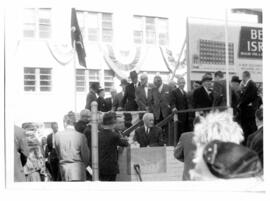The files in this collection primarily cover The Mount Sinai Hospital's doctors and nurses stationed at the 3rd General Hospital. Details about Mount Sinai clinicians and staff in active duty stationed at other locations during World War II are found in the publication Grand Rounds: Memos from Mount Sinai Men to their Fellows in the Services. The records cover the time period from 1942 through 1945.
A prominent item in this collection is Ralph Moloshok's unpublished historical account. The manuscript provides a detailed chronicle of Dr. Moloshok's experiences in basic training at Camp Rucker, and his active duty at the 3rd General Hospital in North Africa. The document is approximately 400 pages long. The first 118 pages are written as a journal, with entries appearing almost daily. These entries provide in-depth descriptions of the weeks spent in basic training at Camp Rucker. The second portion of the manuscript details the move to Casablanca, and finally the order to begin duty at the 3rd General Hospital in Tunisia.
The value of this manuscript is not just in its detailed descriptions of people, living conditions and medical military life, it also includes affixed original documents outlining the officers' schedules and basic training routines, anecdotes, illustrations (with no identifiable artist attribution), and photographs from Camp Rucker, Casablanca, Italy and France.
With so much of Mount Sinai's attention and resources turned toward the war effort, the Hospital moved to address the growing interest in information about the men and women in service at the 3rd General Hospital, as well as those assigned to other units in the war. Two members of Mount Sinai's administration, Sol Weiner Ginsburg, MD and Bella Trachtenberg responded by collecting, printing, binding and distributing the letters written by doctors in the war. These quarterly editions, called Grand Rounds: Memos from Mount Sinai Men to their Fellows in the Services, became wildly popular at home and among the soldiers serving abroad and within the United States. The compilation contains World War II letters and letter excerpts from September 1943 through October 1945.
Other important items in this collection are two scrapbooks on the nursing staff's military service during World War II. One was created by the Department of Nursing, the other by the Alumnae Association of The Mount Sinai Hospital School of Nursing. The scrapbooks include official military and hospital correspondence to and from the nursing staff in the form of letters and memoranda that range from 1942 through 1945. An interesting part of the Dept. of Nursing's scrapbook is the more casual correspondence such as greeting cards, personal notes, marriage and birth announcements, and Victory Mail (V-Mail). The greeting cards are addressed to the unit as well as to individuals. Some of the cards are hand painted. Samples of unused V-mail, intended to send holiday greetings (Mother's Day, Easter, and Christmas), are also included. Other loose items in the scrapbook include programs from amateur performances by the nurses and medical officers, concerts and religious services. The religious programs represent both Christian and Jewish faith observances at the 3rd General Hospital.
Other noteworthy scrapbook items include an original April 13, 1945 issue of Stars and Stripes announcing President Franklin D. Roosevelt's death. There are also various newsletters produced by and for the officers. These include issues of BBC News, Stethoscope 3rd General, and The Trooper. Several issues in this sampling are incomplete.
The bound pages of the scrapbook from the Alumnae Association of The Mount Sinai Hospital School of Nursing contains numerous keepsake items, mementos from various events, and personal and official correspondence to 1st Lt. Ruth Chamberlin, who served as Chief Nurse at the 3rd General Hospital.
In addition to this print material, the collection also includes an audio recording (VM_012) and printed transcript of The Story of Two Hospitals, as recorded by Robert St. John, an NBC war correspondent, in November 1943. There is also film footage related to the 3rd General Hospital that was taken by Dr. Henry Horn, a Mount Sinai staff member who was in the Unit. This includes footage from the Unit starting in North Africa and continuing through France, including a trip to Paris and the Follies Bergère. His wife later gave the film to the Hospital. All six reels of the film were digitized in 2005.
![Letter [from Louis J. Frank?] to Captain Leo B. Meyer](/uploads/r/arthur-h-aufses-jr-md-archives/8/d/5/8d55486db2adcb0f919849f2520495c96c45c72b306ea6a031b67b2263164331/2769ca34-1f03-4d96-861b-d4b0cd9e1fad-0081-0082_142.jpg)
![Letter [from Louis J. Frank?] from Sam [Private S. E. Mintzer?] [reproduction]](/uploads/r/arthur-h-aufses-jr-md-archives/4/3/5/4357462669d2420a4e45cfbad058617fa53da659c7a5caaee93143bede662db1/bde73a50-5108-4ba5-9119-c28f850e1626-0088_142.jpg)
![Letter [from Louis J. Frank?] to Lieutenant Colonel Samuel J. Kopetzky [reproduction]](/uploads/r/arthur-h-aufses-jr-md-archives/2/c/6/2c6ee0704e27b3fa56b524c3de85b4952931ee6de1c7c073efff01324c776962/dfd96915-b097-48b8-bf51-b81e544a8f57-0102_142.jpg)


